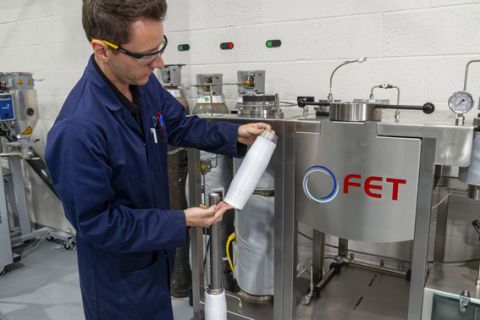FET has developed and patented(1) technology that enables it to use supercritical carbon dioxide (CO2) as a washing solvent for the production of UHMWPE fibres. Conventional processes for the manufacture of UHMWPE fibres involve the use of large volumes of hazardous solvents, such as dichloromethane (DCM) or, more recently, hexane. First, UHMWPE powder is dissolved in mineral oil to form a gel that is subsequently extruded, cooled and solidified. The oil is extracted from the fibres using DCM or hexane and the solid fibres are then drawn at high temperature to align the polymer chains further in the UHMWPE, resulting in strong and tough fibres. Typically, it takes 10 kg of hexane to extract 1 kg of oil.
FET’s Senior Material and Process Scientist, Kris Kortsen, says: “[Mineral oil] reclamation using extraction baths and hot-air drying chambers is not practical for the scale of our system. The current baths employed can be up to 200 m long and the waste volumes are considerable. Expertise is needed in dealing with such dangerous chemicals and overall, the process has an immense environmental impact. CO2, by contrast, is a cheap and abundant sustainable solvent that is non-toxic, non-flammable and leaves no residue.”
A Research and Development Manager at FET, Jonny Hunter, adds: “The current systems for manufacturing UHMWPE filament yarns are on a huge scale, with very complex processing routes. This means the supply chain is currently very inflexible with minimal opportunity for new product development. These disadvantages have been fully addressed in the development of our new FET-500 series laboratory- and small-scale gel-spinning system.”
FET’s closed-loop system can recover more than 95% of the mineral oil used in the production of UHMWPE fibres. Further, the FET-500 features a highly modular drawing system based on heated godet rollers, enabling the temperature and drawing tension to be customised and controlled precisely.
FET is currently preparing a comprehensive life-cycle analysis (LCA) to detail the full benefits of its the technology.
UHMWPE fibres are used widely to produce high-performance ropes, antiballistic body armour, cut-resistant clothing, high-performance sportswear and, increasingly, in biomedical applications (in sutures, for instance). FET's Managing Director, Richard Slack, says: “FET has supplied many extrusion systems to the biomedical market, most notably for the production of both resorbable and non-absorbable sutures. In exploring what else we could do in assisting these customers, it became clear that there was a need for smaller quantities of UHMWPE fibres in bespoke sizes.”
Slack concludes: “We believe there is a big gap in the market for smaller quantities of UHMWPE, and our first line is now fully operational at the FET Fibre Development Centre(2) in Leeds. We look forward to demonstrating it and discussing its full potential with interested companies from around the world.”

